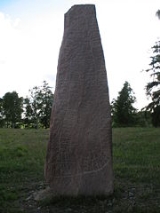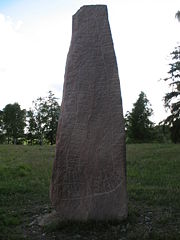
Norra Härene Runestone
Encyclopedia

Rundata
The Scandinavian Runic-text Data Base is a project involving the creation and maintenance of a database of runic inscriptions. The project's goal is to comprehensively catalog runestones in a machine-readable way for future research...
, is a Viking Age
Viking Age
Viking Age is the term for the period in European history, especially Northern European and Scandinavian history, spanning the late 8th to 11th centuries. Scandinavian Vikings explored Europe by its oceans and rivers through trade and warfare. The Vikings also reached Iceland, Greenland,...
memorial runestone that is located on the grounds of Dagsnäs Castle
Dagsnäs Castle
Dagsnäs Castle is a castle in Sweden, situated 9 kilometer south of Skara at Lake Hornborga....
about seven kilometers south of Skara
Skara
Skara is a locality and the seat of Skara Municipality, Västra Götaland County, Sweden with 18595 inhabitants in 2005. Despite its small size, it has a long educational and ecclesiastical history. One of Sweden's oldest high schools, Katedralskolan , is situated in Skara...
in Västergötland
Västergötland
', English exonym: West Gothland, is one of the 25 traditional non-administrative provinces of Sweden , situated in the southwest of Sweden. In older English literature one may also encounter the Latinized version Westrogothia....
, Sweden
Sweden
Sweden , officially the Kingdom of Sweden , is a Nordic country on the Scandinavian Peninsula in Northern Europe. Sweden borders with Norway and Finland and is connected to Denmark by a bridge-tunnel across the Öresund....
.
Description
This runestone is a very tall granite stone that is 3.3 metres tall and 1 metre wide. It was discovered in 1795 in the walls of the church of Norra Härene, which has been a ruin since the 17th century.The runic text describes the deceased man Fótr as being "a very good thegn
Thegn
The term thegn , from OE þegn, ðegn "servant, attendant, retainer", is commonly used to describe either an aristocratic retainer of a king or nobleman in Anglo-Saxon England, or as a class term, the majority of the aristocracy below the ranks of ealdormen and high-reeves...
." The term thegn was used in the late Viking Age in Sweden and Denmark to describe a class of retainer. About fifty memorial runestones described the deceased as being a thegn. Of these, the runic text on other sixteen runestones uses the same Old Norse
Old Norse
Old Norse is a North Germanic language that was spoken by inhabitants of Scandinavia and inhabitants of their overseas settlements during the Viking Age, until about 1300....
phrase harða goðan þegn, Vg 62
Ballstorp Runestone
The Ballstorp Runestone, listed as Vg 62 in the Rundata catalog, is a Viking Age memorial runestone located on the grounds of the ruins of a church in Ballstorp, which is about 8 kilometers northwest of Floby, Västra Götaland County, Sweden, which is in the historic province of...
in Ballstorp, Vg 102 in Håle gamla, Vg 113 in Lärkegape, Vg 115 in Stora Västölet, Vg 151 in Eggvena, Vg NOR1997;27 in Hols, DR 86 in Langå, DR 106 in Ørum, DR 115 in Randers
Randers
Randers is a city in Randers municipality on the Jutland peninsula in central Denmark. It is Denmark's sixth-largest city, with a population of 60,656 . Randers city is the main town of the municipality and the site of its municipal council.-Overview:Randers municipality has 94,750 inhabitants...
, DR 121 in Asferg, DR 123 in Glenstrup, DR 130 in Giver, DR 213 in Skovlænge, DR 278
Västra Nöbbelöv Runestone
The Västra Nöbbelöv Runestone, listed as DR 278 in the Rundata catalog, is a Viking Age memorial runestone located in Västra Nöbbelöv, which is about 3 kilometers east of Skivarp, Skåne County, Sweden, and was in the historic province of Scania....
in Västra Nöbbelöv, DR 294 in Baldringe, and DR 343 in Östra Herrestads. In addition, four inscriptions use a different word order, þegn harða goðan, include Vg 74 in Skolgården, Vg 152 in Håkansgården, Vg 157 in Storegården, and Vg 158 in Fänneslunda.
The text also states that the deceased man's wife Ása made something "as no other wife in memory of (her) husband will," but does not state what she made. One suggestion is that she composed a lament for her husband.
Transliteration of the runes into Latin characters
- rifnikR : auk : kiali : auk : brunulfR : auk : kifulfR : satu : stin : þonsi : iftiR : fut : faþur : sin : harþa : kuþon : þign : sua : hifiR : osa : as : igi : mun : sum : kuin : ift : uir : siþon : kaurua :: hialmR : auk : hiali : hiaku : runaR *
Transcription into Old Norse
- HræfningR ok Gialli ok BrunulfR ok GefulfR sattu stæin þannsi æftiR Fot, faður sinn, harða goðan þegn. Sva hæfiR Asa es æigi mun sum kvæn æft ver siðan gærva. HialmR ok Hialli hioggu runaR.
Translation in English
- Hrefningr and Gjalli and Brynjulfr and Gjafulfr placed this stone in memory of Fótr, their father, a very good thegn. Thus has Ása made, as no other wife in memory of (her) husband will. Hjalmr and Hjalli cut the runes.

